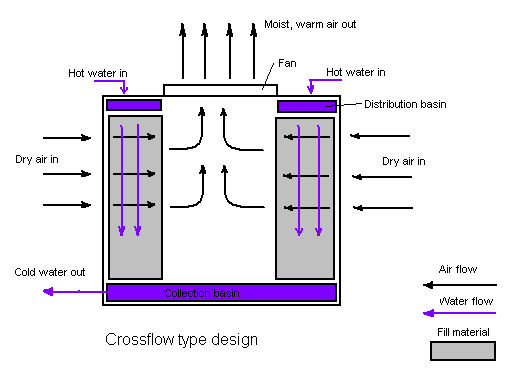|
Cooling Tower
Cooling towers are evaporative coolers used for cooling water
or other working medium to near-ambient temperature. Cooling towers
use evaporation of water to reject heat from the system. They
vary in size from small roof-top units to very large hyperbolic
structures (as in Image 1) that can be over 120 meters tall and
100 meters in length or rectangular structures (as in Image 2)
that can be over 40 meters tall and 80 meters long.Cooling towers
can generally be classifed by use into either industrial or HVAC
(air-conditioning) duty.
Industrial cooling towers can by used to reject heat from various
sources such as machinery or heated process material.
An HVAC cooling tower is a subcategory rejecting heat generated
by a chiller. As heat loads increase, water-cooled chillers are
more energy efficient than air-cooled chillers. Large office buildings,
hospitals, schools typically use a cooling tower as part of their
air conditioning systems.
Generally, industrial cooling towers are much larger than HVAC
towers and are entirely erected on site. HVAC cooling towers can
be compact enough to factory assemble and ship nearly complete.
 |
Cooling towers are used in central air conditioning systems.
The function of the cooling tower is to cool the warm water
from the chiller condenser. Following the central air conditioning
system cycle, the heat from the rooms in a building is transferred
to chilled water, which is then transferred into the refrigerant,
and finally to the cooling water. The cooling tower is at
the final point of the heat transfer. The heat is transferred
to the atmosphere.
The heat in the cooling water is removed by letting moving
air come into contact with it. Water is normally spread
out and allowed to drop down by gravity from a height. Plastic
fillings are arranged so as to increase the wetted surface
of the water while it is dropping, while at the same time
provide better contact between the air passages and the
water.
There are basically 2 types of designs:
Cross Flow
Counter Flow
Cross Flow |
|
|
|
|
As the name suggests, the flow of water is at right angles to
the flow of air. The cooling tower for this type of design is
usually shaped like a box. Warm water is pumped to the top of
the cooling tower where it is distributed to the sides and allowed
to drop through small holes. Plastic air intake louvers at the
sides of the cooling tower allow the water to spread out while
dropping. Air from the outside is sucked into the cooling tower
by several fans located at the top. The incoming air comes into
contact with the dropping water, and the latter is cooled. The
cooled water is collected at the bottom of cooling tower. This
water is then pumped out again and circulated through the chiller.
The heat from the chiller is transferred to it again. The warm
water then returns back to the top of the cooling tower and the
cycle starts again.
Counter Flow
Counter flow cooling towers have the air passage flowing directly
against the flow of the water. As with the cross flow design,
water is allowed to spread out with the help of air inlet louvers.
Their bottle like shape characterizes this type of cooling towers.
There is only one single fan at the center. Fitted below the fan
is a rotating water pipe distributor. The pipes of the water distributor
shoots water only from one side. The action of the water pressure
shooting from one side rotates the distributor. The water is thus
dropped evenly over the air inlet louvers. The water dropping
by gravity meets head on with the up moving air current sucked
in by the fan. The air cools the water. The water collected at
the bottom of the cooling tower is pumped to the chiller, becomes
heated up again, and is then returned back to the cooling tower
for cooling.
Water Treatment
In cooling towers, the cooling effect is achieved by evaporation
of a portion of the water passing through it. As the water is
evaporated, impurities remain in the recirculating water. The
concentration of the dissolved solids increases rapidly and can
reach unacceptable levels. In addition, airborne impurities are
often introduced into the water. If the contaminants are not controlled,
they can cause scaling, corrosion, and sludge accumulations which
can reduce heat transfer efficiencies.
In order to control the concentrations, it is necessary to bleed
a small amount of circulating water from the system and top up
with fresh water. If the site conditions are such that constant
bleed-off will not control scale or corrosion, chemical treatment
is necessary. Even with bleed-off or chemical treatment, it is
still necessary to control biological contamination. The growth
of algae, and other microorganisms can reduce system efficiency
and may even contribute to potentially health hazards. Biocides
are used to treat the water to control the biological growths
Cooling Tower Water Management
|

